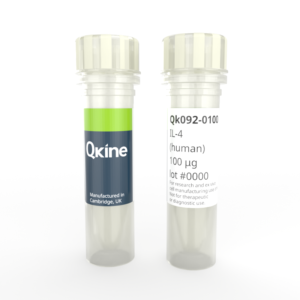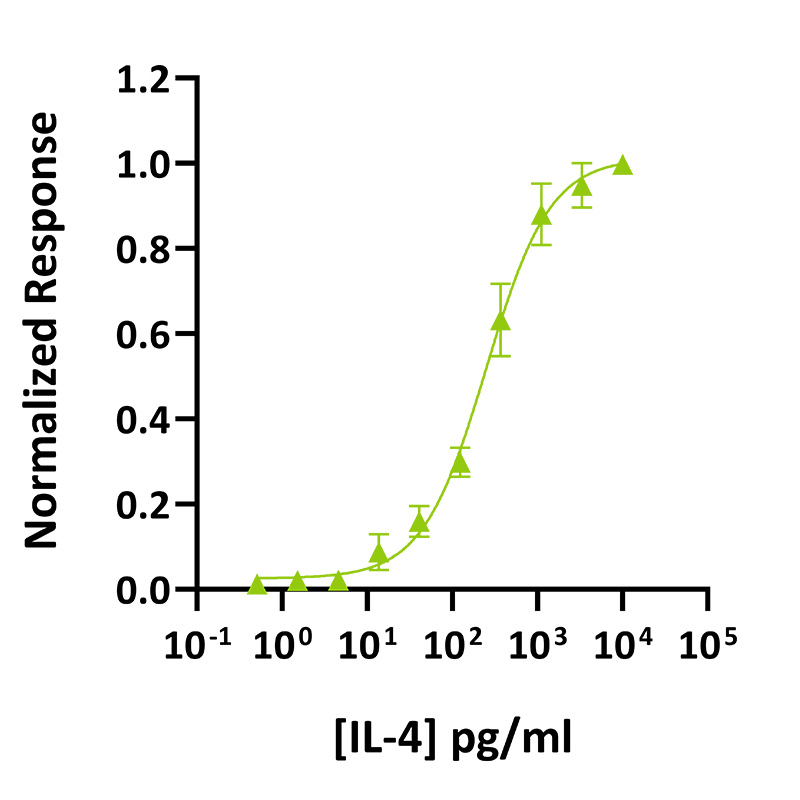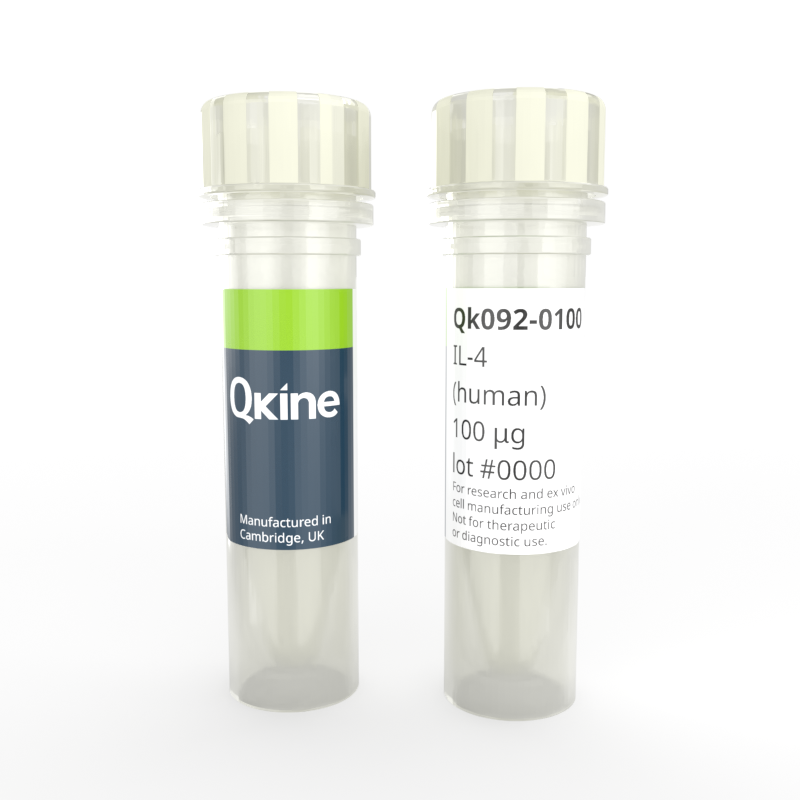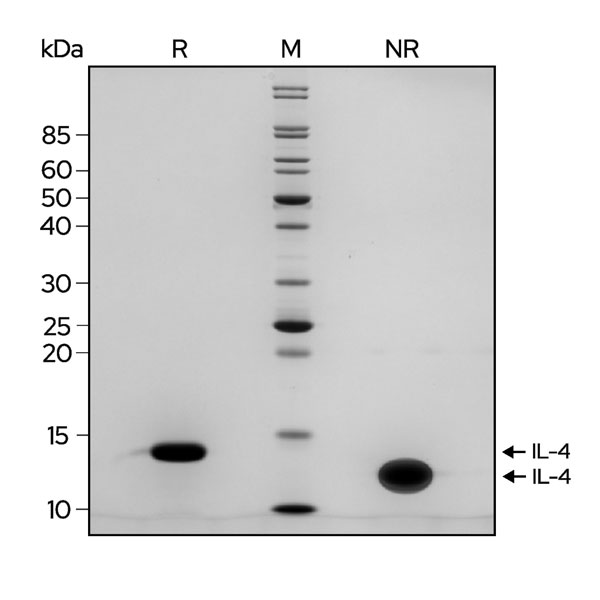 Recombinant human IL-4 protein (Qk092)
Recombinant human IL-4 protein (Qk092)Recombinant human IL-4 protein (Qk092)
Price range: £230.00 through £2,900.00
Interleukin-4 (IL-4) is a pleiotropic, immune-modulatory cytokine that is secreted primarily by mast cells, T-cells, eosinophils, and basophils. IL-4 plays a crucial role in hematopoiesis, the regulation of antibody production, the stimulation of activated B cell and T cell proliferation, and the differentiation of B cells into plasma cells.
Human IL-4 has a molecular weight of 15.1 kDa. This protein is animal origin-free, carrier-free and tag-free to ensure its purity with exceptional lot-to-lot consistency. Qk092 is suitable for the culture of reproducible and high-quality stem cells and other relevant cells.
In stock
Orders are typically shipped same or next day (except Friday).
Easy world-wide ordering, direct or through our distributors.
Price range: £230.00 through £2,900.00
Buy online with secure credit card or purchase order. For any questions, please email orders@qkine.com
Summary:
- High purity human IL-4 protein (Uniprot number: P05112)
- 15.1 kDa (monomer)
>98%, by SDS-PAGE quantitative densitometry
Expressed in E. coli
Animal origin-free (AOF) and carrier protein-free
Manufactured in our Cambridge, UK laboratories
Lyophilized from acetonitrile, TFA
- Resuspend in sterile-filtered water at >50 µg/ml, add carrier protein if desired, prepare single use aliquots and store frozen at -20 °C (short-term) or -80 °C (long-term).
Featured applications:
Stimulation of activated T cell proliferation
Stimulation of activated B cell proliferation
Differentiation of B cells into plasma cells
Lymphoid differentiation

IL-4 activity was determined using proliferation of TF-1 human myeloid leukemia cells. EC50 = 235 pg/mL (16 pM). Cells were treated in triplicate with a serial dilution of IL-4 for 72 hours. Cell viability was measured using the CellTiter-Glo (Promega) luminescence assay. Data from Qk092 lot #204598.
Recombinant IL-4 migrates as a major band at approximately 14 kDa in non-reducing (NR) and at approximately 12.5 kDa in reduced (R) conditions. No contaminating protein bands are present. The purified recombinant protein (3 µg) was resolved using 15% w/v SDS-PAGE in reduced (+β-mercaptoethanol, R) and non-reduced conditions and stained with Coomassie Brilliant Blue R250. Data from Qk092 batch #204598.

Further quality assays
Mass spectrometry: single species with expected mass
Recovery from stock vial: >95%
Endotoxin: <0.005 EU/μg protein (below level of detection)
We are a company founded and run by scientists to provide a service and support innovation in stem cell biology and regenerative medicine. All our products are exceptionally high purity, with complete characterisation and bioactivity analysis on every lot.

Qkine IL-4 is as biologically active as a comparable alternative supplier protein. Stimulation of proliferation of TF-1 cells with Qkine IL-4 (Qk092, green) and alternative supplier IL-4 (Supplier B, black). Cells were treated in triplicate with a serial dilution of IL-4 for 72 hours and proliferation measured using the CellTiter-Glo (Promega) luminescence assay.
Technote | IL-4 (Qk092) bioactivityProtein background
Interleukin 4 (IL-4) is an important signaling molecule within the immune system, playing multiple roles in orchestrating immune responses and maintaining immune homeostasis. IL-4 is primarily produced by immune cells, including mast cells, T helper 2 (Th2) cells, eosinophils, and basophils, and exerts its effects through interaction with its specific receptor, IL-4Rα and subsequent activation of downstream signaling pathways [1]. IL-4 plays a crucial role in hematopoiesis, the regulation of antibody production, the stimulation of activated B cell and T cell proliferation, and the differentiation of B cells into plasma cells. IL-4 induces the expression of class II MHC molecules on resting B-cells and aids regulation of the low-affinity Fc receptor for IgE (CD23) expression on lymphocytes and monocytes [2].
IL-4 has a compact, globular fold stabilized by three disulfide bonds. IL-4 consists of a characteristic four-alpha helix bundle with a left-handed twist, along with a two-stranded anti-parallel beta-sheet [2]. This structural arrangement allows stability to IL-4 and also facilitates its interaction with its receptor, IL-4Rα. The receptor for IL-4, IL-4Rα, exists in three distinct complexes within the body, each playing a crucial role in mediating IL-4 signaling [3]. Type 1 receptors consist of the IL-4Rα subunit coupled with a common gamma chain, while type 2 receptors comprise the IL-4Rα subunit bound to IL-13Rα1. Type 1 receptors specifically bind IL-4, whereas type 2 receptors have the capacity to bind both IL-4 and IL-13, two cytokines with closely related functions. This differential receptor composition allows for nuanced regulation of immune responses depending on the specific ligands present [4].
IL-4 serves as a regulator of immune cell differentiation and activation [5]. It promotes the differentiation of naive T cells into Th2 cells, which are crucial for orchestrating immune responses against extracellular pathogens and for mediating allergic reactions. Additionally, IL-4 stimulates the proliferation and activation of B cells, leading to the production of antibodies and the formation of memory B cells [6]. IL-4 plays a pivotal role in modulating macrophage polarization and the development of an alternative activation phenotype (M2) associated with tissue repair and resolution of inflammation [7].
In the context of disease, dysregulation of IL-4 signaling has been implicated in various immune disorders, including allergies, asthma, and autoimmune diseases. Enhanced IL-4 production or aberrant IL-4 receptor signaling can contribute to the pathogenesis of allergic inflammation and tissue damage. Therapeutic strategies aimed at targeting IL-4 or its receptor have shown promise in treating these conditions by modulating immune responses and dampening inflammation [8].
Our products are for research use only and not for diagnostic or therapeutic use. Products are not for resale.
For use in manufacturing of cellular or gene therapy products. Not intended for in vivo applications.

Receive an Amazon gift voucher when you leave us a review.
£25, $30 or €30 for reviews with an image and £10, $15 or €15 for reviews without an image

